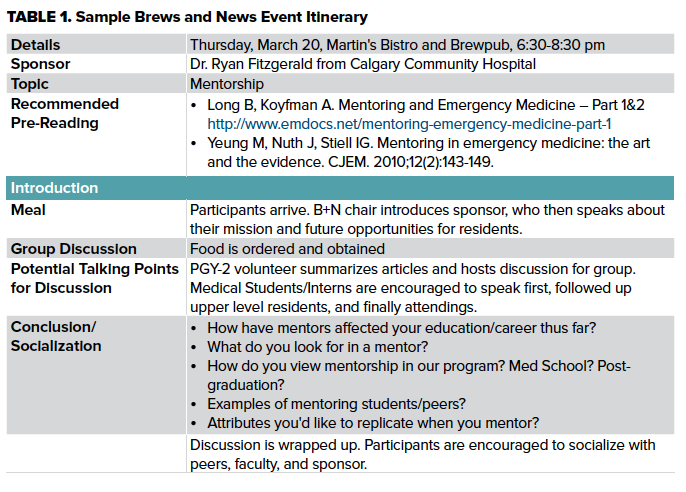Resident-driven, extracurricular topical discussions can improve and support resident wellness in an emergency medicine (EM) residency.
Geisinger Medical Center has developed an innovative, collaborative model that serves as a means of social bonding and a venue for discussing various topics that may not fit into traditional EM curricula. The name “Brews and News” sets the stage for social interaction and fellowship, to discuss topics affecting emergency medicine residents and physicians - it is not a suggestion or sponsorship of alcohol consumption.
BACKGROUND
Wellness has emerged as a crucial part of emergency medicine training and practice. The definition of wellness varies from individual to individual, but includes sleep hygiene, nutrition and fitness, access to mental health resources, and the enigmatic “work-life balance.” Given the association between burnout and medical errors,1 and increased risk of mental health disorders and suicide in physicians,2 the benefits of wellness cannot be understated.
Many residency programs have developed wellness curricula3,4 that provide a multi-faceted approach to improving resident wellbeing, both professionally and personally. A potentially high yield strategy for fostering wellness is strengthening residents’ social connections, which has been shown to have a positive effect on their wellbeing.5,6 There are factors unique to emergency medicine that likely contribute to the specialty’s higher burnout rate compared to physician peers in other specialties.7,8 These factors are often concentrated while in residency, which intensify both the challenge and opportunity to address these factors, which include shift work and social support.9
We describe a model educational innovation for wellness and topical discussion that has been developed by residents at the Geisinger Medical Center Emergency Medicine residency program. This innovation has created a unique, resident-driven wellness activity to provide for socialization and camaraderie and to promote bonding and important discussions outside of the hospital. Dubbed “Brews and News”, this monthly, evening, off-campus gathering of residents, medical students, and faculty has shown benefits to all those who participate.
INNOVATION
“Brews and News” is held monthly for several hours in the evening at an off-campus venue such as a restaurant or faculty home. The event is sponsored usually by an employer, or other organization with a relationship to the specialty of emergency medicine. The sponsor is approached by residents and approved by program leadership. The sponsor has the opportunity to discuss their organization briefly during the event. “Brews and News” was developed at the same time that our residency assimilated journal club into the on-campus, didactic curriculum schedule rather than an evening event. Resident champions for the program, with input from their fellow residents and faculty, plan an event and select topics to discuss.
While residents set the agenda and select the activities and discussion topics, faculty, medical students, and families also are invited. This creates an informal opportunity to relax and learn about each other outside of the structure of didactics, clinical responsibilities, and journal club. Further, this format encourages discussion of topics that impact residents, faculty, and families in emergency medicine (Table 1).

IMPLEMENTATION
Despite the name, “Brew and News” is not predicated on alcohol consumption or solely on current events. The title sets an informal tone for these monthly events. We stress that these events should be resident-driven in terms of location, time, and topics discussed. We chose one “Brews and News” champion from each resident class (can include the Wellness Chief/Resident) to help arrange sponsors, location, dates and time and encouraged input from residents and faculty on topics of interest. In our model, we found holding events once a month and at a variety of easily accessible and new locations (including restaurants, brewpubs, faculty/resident homes, outdoor parks with barbeque facilities) allowed us to keep the events both consistent and helped to maximize attendance. The majority of events had meals sponsored by a variety of groups such as staffing companies, financial advisors, fellowship directors, and local hospitals. In addition to sponsors, our program encouraged attendance and input from medical students and resident’s significant others (clinical and non-clinical) which helped not only with wellness and recruitment but also helped provide a variety of perspectives on topics.
Topics discussed during “Brews and News” varied widely, with most being outside of the realm of peer-reviewed scientific literature, focusing instead on issues such as current events, challenges of residency, job market issues, or humanities in medicine. Depending on the topic, that event’s moderator (either “Brews and News” resident champion or other resident who volunteered) would submit 1-3 articles (depending on length and topic) to help frame the discussion. We encouraged a variety of input materials including articles from newspapers, medical blogs, YouTube clips, or podcasts. Keeping the events optional, resident-led and in an informal, low-pressure environment encouraged open discussion and exchange of ideas. We found that inviting input first from medical students, followed by residents, and then lastly from attendings as a method of encouraging exchange from a variety of perspectives and experiences and allowed for conversations not typically encountered in a structured journal club.
Several “Brews and News” events each calendar year included physical wellness and team-building activities such as a short canoe trip, bowling, a “rage room”, all followed by drinks, food, and conversation. During the COVID-19 pandemic a take-out meal with online video chat allowed for “Brews and News” to continue.
OUTCOMES
In the 2 years since its implementation, we have seen multiple intangible positive outcomes. In addition to providing a regular event for bonding and wellness, it has also become an informal, open environment for engaging discussions of various topics outside of the traditional EM didactic curriculum. A resident-driven event such as this also has given residents leadership opportunities in roles such as curriculum design and moderating discussions, important skills in both community and academic settings. Additionally, it has provided a key tool for recruitment of medical students by introducing them not only to the program, but also to the residents, and provided a venue for residents to interact with prospective employers, including fellowship opportunities.
LESSONS LEARNED
Various challenges to implementation exist. Most important, attendance is key. A balance of keeping these events routine (monthly) yet flexible is critical to success. Our model worked well in the evenings, as our journal club has been moved from monthly evening meetings to our morning didactics. Selecting a variety of different venues with sponsored food and drinks encourage attendance. Finally, because residents select topics of interest, there is investment and engagement in robust discussions.
Participation in the discussion is important but can sometimes be difficult depending on the topic, reinforcing the need to keep topic selection up to residents. Sending articles ahead (we found 5-7 days the ideal lead time) is key to an informed discussion. Moderators should come prepared with important questions or summary statements to spur discussion. Programs may decide to discuss political or other polarizing topics related to medicine; while these can be engaging and eye-opening exchanges, resident-moderators must ensure an environment of open, civil discourse.
When choosing a venue, ensure your group will have a private or semi-private space with enough room for all participants, a layout that encourages open dialogue, and remains out of earshot of other groups, as sensitive topics related to medicine might be discussed. Many venues will arrange a separate side room or rent out the entire space. Sponsors help fund these events outside of department budgets and often provide insight on various topics and opportunities. Good attendance and open communication with sponsors (before and after the event) are key to maintaining good relationships for future events.
Transitioning leadership of “Brews and News” for continuity and consistency can also be challenging. Our model encourages a champion from each post-graduate year residency class to help organize the events, as a way to share the responsibilities of event planning, establish continuity, increase resident buy-in, and help ensure diversity of venues and discussion topics.
CONCLUSION
We present “Brews and News” as a model for integrating wellness and resident-driven extra-curricular topical discussions that supplements as a format to run separate but in complement to the traditional journal club format. While challenges to implementation exist, including timing, attendance, and competing events, these can be overcome by keeping the schedule flexible and resident-driven to encourage participation and to maximize the many benefits including wellness, resident-leadership, and fruitful discussion on topics important to today’s trainees.
REFERENCES
- Shanafelt TD, Balch CM, Bechamps G, et al. Burnout and medical errors among American surgeons. Ann Surg. 2010;251:995-1000.
- Frank E, Biola H, Burnett CA. Mortality rates and causes among US physicians. Am J Prev Med. 2000;19(3):155–9.
- Salles A, Liebert CA, Greco RS. Promoting balance in the lives of resident-physicians. JAMA Surg. 2015; 150(7): 607-8.
- Williamson K, Lank PM, Lovell EO. Emergency Medicine Education Research Alliance (EMERA). Development of an Emergency Medicine Wellness Curriculum. AEM Educ Train. 2017;2(1):20–5.
- Williamson K, Lank PM, Lovell EO. Re: Development of an Emergency Medicine Wellness Curriculum. AEM Educ Train. 2019;3(2):202.
- Raj KS. Well-Being in Residency: A Systematic Review. J Grad Med Educ. 2016;8(5):674-84.
- Shanfelt TD, Boone S, Tan L, et al. Burnout and satisfaction with work-life balance among US physicians relative to general US population. Arch Intern Med. 2012;172:1-9.
- Berger E. Physician Burnout. Ann Emerg Med. 2013;61(3):A17-9.
- Houry D, Shockley LW, Markovchick V. Wellness and the Emergency Medicine Resident. Ann Emerg Med. 2000;35(4);394-397.



